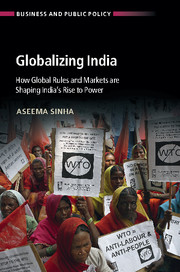Book contents
- Frontmatter
- Dedication
- Contents
- List of figures
- List of tables
- Preface and acknowledgments
- Note on currency translation
- List of abbreviations
- 1 How global rules and markets are shaping India's rise to power
- 2 A theory of causal mechanisms and Global Design-in-Motion
- 3 Trade, statecraft, and state capacity in India
- 4 Realigning interests toward global reach: Changes in India's pharmaceutical sector
- 5 Mobilizing new interests and tying the state's hands: Decline and revival in the textile sector
- 6 Interests in motion: Private sector change in India's textile sector
- 7 Mechanisms of change within global markets
- 8 Conclusion
- Appendix: Field trips, and list of interviews, and libraries visited
- References
- Index
5 - Mobilizing new interests and tying the state's hands: Decline and revival in the textile sector
Published online by Cambridge University Press: 05 April 2016
- Frontmatter
- Dedication
- Contents
- List of figures
- List of tables
- Preface and acknowledgments
- Note on currency translation
- List of abbreviations
- 1 How global rules and markets are shaping India's rise to power
- 2 A theory of causal mechanisms and Global Design-in-Motion
- 3 Trade, statecraft, and state capacity in India
- 4 Realigning interests toward global reach: Changes in India's pharmaceutical sector
- 5 Mobilizing new interests and tying the state's hands: Decline and revival in the textile sector
- 6 Interests in motion: Private sector change in India's textile sector
- 7 Mechanisms of change within global markets
- 8 Conclusion
- Appendix: Field trips, and list of interviews, and libraries visited
- References
- Index
Summary
Who are the authors and agents of India's global integration? In this chapter and the next, I explicate the process of policy and private sector change in an important sector – textiles and garments – by focusing on the agents who reintegrated India with the global economy. The global Multifibre Arrangement (MFA), a nested agreement within the WTO, which instituted quotas in the 1960s, was to be replaced by the Agreement on Textiles and Clothing (ATC) in 2005, wherein all previously existing quotas were to be eliminated and all countries were free to export and import textile goods. In India, this prospective abolition activated reform elements within the state, who became authors of a fundamental change in policy direction starting in 1999–2000. Globalist notions considered impossible to implement just a few months before became “the idea whose time has come.” How did this happen?
The impending global change ruptured the preexisting industrial order in India, creating a window of opportunity for new growth strategies and a favorable inclination toward the global market. In contrast to prevailing views that see state actions to be negative and ineffective, I show that the Indian state became a leader of policy change, revitalized and mobilized by the perceived threat of the onset of global trade rules in the textile sector. Some state agents used India's commitment to abolishing the Multifibre Agreement in 2005 to encourage domestic businesses to transform their decades-old ways of doing business, and tying their hands in favor of reform. In order to do this, they fought many vested interests within the state and private sector. This precommitment by the state (tying of one's hand) convinced the usually hesitant private actors that state aid for protectionist interests would not be forthcoming. This pushed them to react to markets, seek global reach, and seek state aid for that purpose.
Why textiles? Douglas Haynes notes, “Cloth … is an invaluable entry point into global economic history.” Echoing that sentiment, I start with the assumption that a study of the textile industry offers a glimpse into the embedding of globalization in India's developmental trajectory over time. The industry accounts for 14 percent of India's industrial production, 4 percent of its GDP, and 13 percent of its export earnings. It employs 35 million people directly, the second largest employment sector after agriculture. Moreover, the textile industry is clearly shaped by global rules.
- Type
- Chapter
- Information
- Globalizing IndiaHow Global Rules and Markets are Shaping India's Rise to Power, pp. 160 - 202Publisher: Cambridge University PressPrint publication year: 2016



